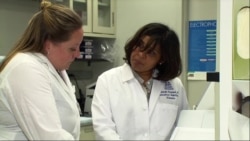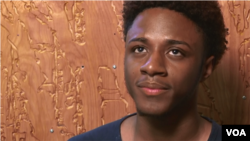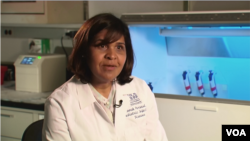Hope and commitment motivate Deborah Persaud. An infectious disease expert, she’s among researchers worldwide who are “on a mission to find a cure for AIDS,” she says. “But this is going to be a very long road.”
An associate professor at Johns Hopkins Children’s Center in Baltimore, Maryland, Persaud is part of a trio – with physicians Hanna Gay and Katherine Luzuriaga – who devised an aggressive drug therapy used on a Mississippi girl born infected with HIV. The girl was considered “functionally” cured after being treated from just after birth for 18 months and then going without medicine at least another year without showing signs of infection. Her recent relapse made headlines when it was divulged earlier this month. Now almost 4, the girl is back on medication.
Even before that setback, Persaud had been cautious.
“We’re all very optimistic because of the biological possibilities, but we do have to remind ourselves that it is a single case,” Persaud told VOA in June, repeating the importance of more study.
Earlier research has led to a significant drop in HIV-infected mothers passing the disease to their children during pregnancy, delivery or through breast feeding, the United Nations’ UNAIDS reports. In the United States, which calls for screening pregnant women for HIV, about 200 infants are born infected each year – down from 900 in 1992. Treatment early in pregnancy cuts the risk of mother-to-child transmission to 2 percent or less, according to the federal Centers for Disease Control and Prevention.
Taking control
The research wasn’t as advanced when Maurice Williams was born two decades ago in Washington, D.C. He contracted the disease from his mother. Now, newly 20, he’s upbeat about managing it.
“When you stay on top of your meds, you stay on top of your life,” he says.
Williams gets regular checkups with his physician, Natella Rakhmanina, a pediatric infectious disease specialist at Children's National Medical Center.
He didn’t learn he was HIV positive until age 13. “I was in the seventh grade,” he recalls. “I found out because I refused to take my medication unless I knew why I was taking medication. "
Williams was raised by his maternal grandmother, Tequilla McLeese. "My daughter was 15 at the time that she had Maurice, so I stepped in and took over,” she explains.
His mother died earlier this year of complications from AIDS. She’d never talked with her son about the virus or his condition.
Anger gives way to acceptance
Williams was “very angry” with his mom for a long time, he says. Eventually, he realized “the anger wasn't beneficial to me. It turned into empathy -- because my mother wasn't even strong enough to really accept the fact that she was HIV positive."
Now, Williams is looking ahead, studying theater arts at Morgan State University in Baltimore, Maryland, and working over the summer to help incoming freshmen adjust to campus life. Away from school, he’s also serving as a mentor to a teenager who’s HIV positive.
“Shani is 13,” Williams says, relating it to his own age of diagnosis. He wished he'd had someone close in age or older to relate to, to help him understand “that taking medicine will get better,” he says. Talking with Shani “does more for me than maybe he even knows."
Williams was encouraged to mentor by his own counselor, Melissa Sellevaag, director of clinical services at Metro Teen AIDS, a community health organization in Washington, D.C.
“I think he’s an incredible role model for other young people who’ve been perinatally infected,” Sellevaag says of Williams. “He understands HIV does not limit who he is, it does not define who he is. He’s stayed engaged with his doctors and supporters. He can expect to live a healthy, full life.”
“I hope when other people look at this [documentary], they feel hope and not pity or sadness,” Sellevaag continues. “Maurice is a model of how you can manage a chronic illness.”
Disclosing his diagnosis
Until now, Williams has been discreet about his own diagnosis and the circumstances of his mother’s death. “A handful of people in my family actually know. My grandmother wanted to keep it a secret,” he says, noting her shame and embarrassment.
“People don’t understand – it’s basically ignorance,” Williams says in a phone interview. But he’s deliberately giving relatives and others a chance to learn and overcome any misunderstandings about HIV/AIDS. “This film is going to make it a conversation piece. Maybe then I’ll have a lot of support.”
"I may not be the person who changes the world, but I want to inspire the mind that does so,” Williams says in the documentary. “I believe that I can be great. I believe I can live a long life. I wasn't supposed to be here now."
A strong encounter
During shooting for the documentary, he and Persaud met to connect the research with the grownup face of a child born with HIV infection.
"People do live with HIV,” Williams says to the doctor. “Times are different now."
Persaud has treated “several hundred kids” since beginning her medical career in the 1980s, she tells VOA.
“I’ve attended many funerals of children and mothers in my lifetime,” the virologist adds. “Fortunately, it’s a less common event now, as Maurice exemplifies. Children can live for a long time – maybe into their 60s, though we don’t know that yet.”
Persaud wants to see even better outcomes for today’s babies.
That includes curbing stigma, which has weighed on Williams as well as other HIV-infected people that Persaud knows. A former honoree with the Elizabeth Glaser Pediatric AIDS Foundation in Washington, D.C., Persaud is friends with Jake Glaser, who’d contracted the illness in utero. (His late mother, Elizabeth, was infected by a blood transfusion while giving birth to daughter Ariel, who died in 1988.) “They certainly faced stigma, not being able to have birthday parties” and being shunned by other children, Persaud says.
“I think we’ve made dramatic progress in terms of stigma,” Persaud continues.
"But we have a lot more work to do to eliminate the stigma of living with HIV/AIDS -- to where it becomes a disease that’s like living with cancer or diabetes or any other chronic illness, because so many people are affected.”
VOA’s Carol Guensburg and Jeff Swicord contributed to this report.












